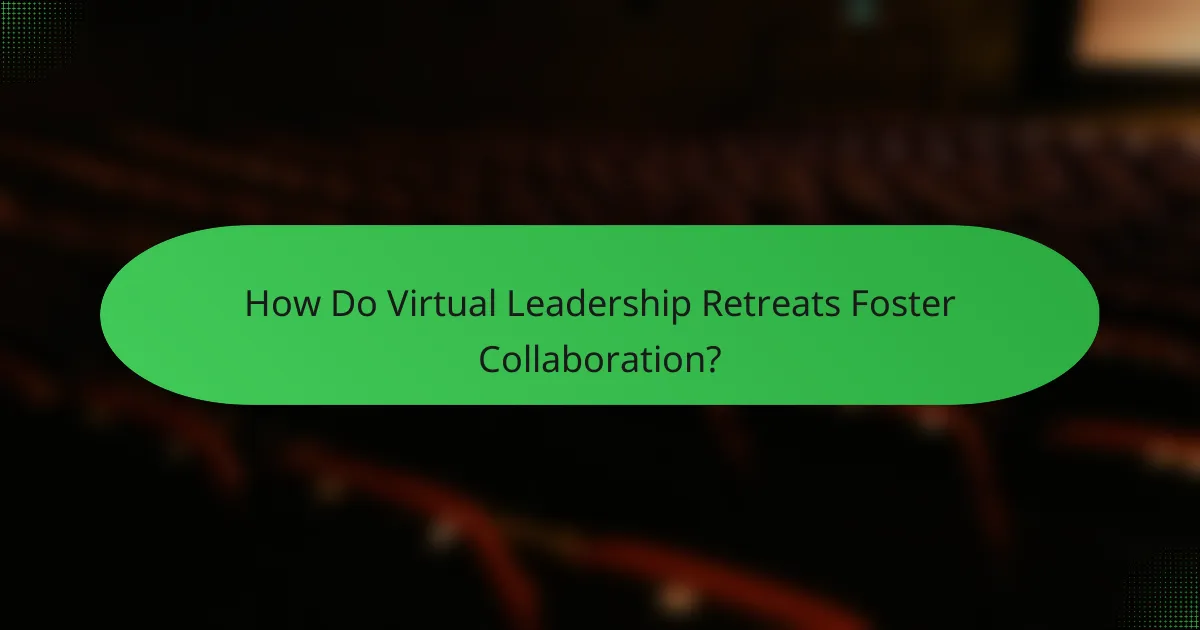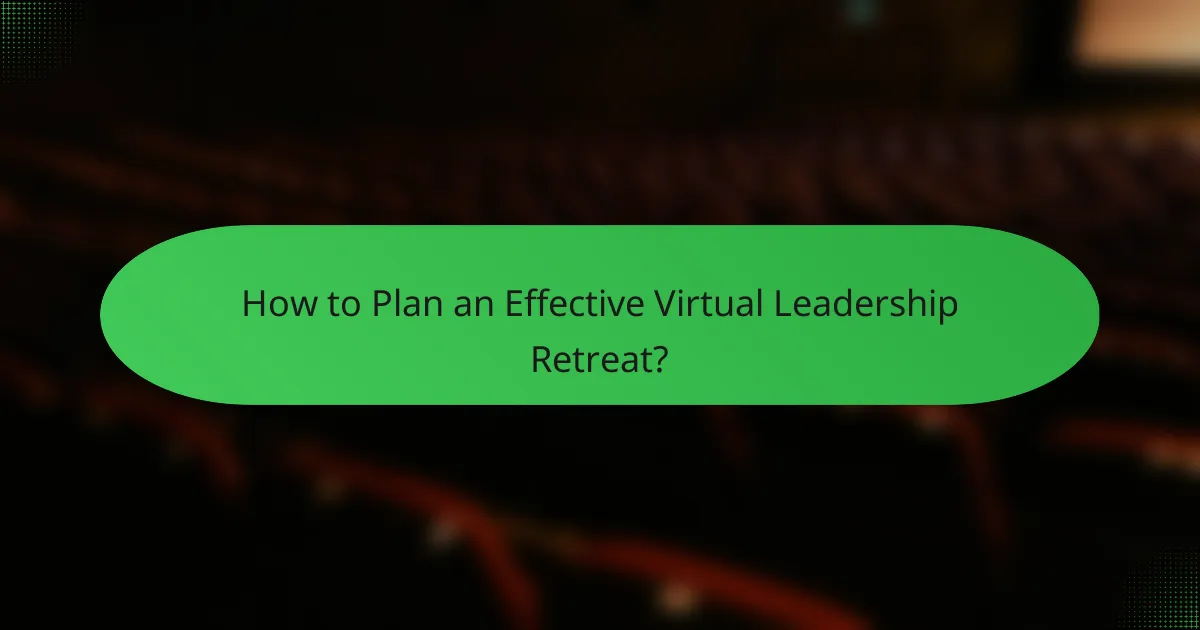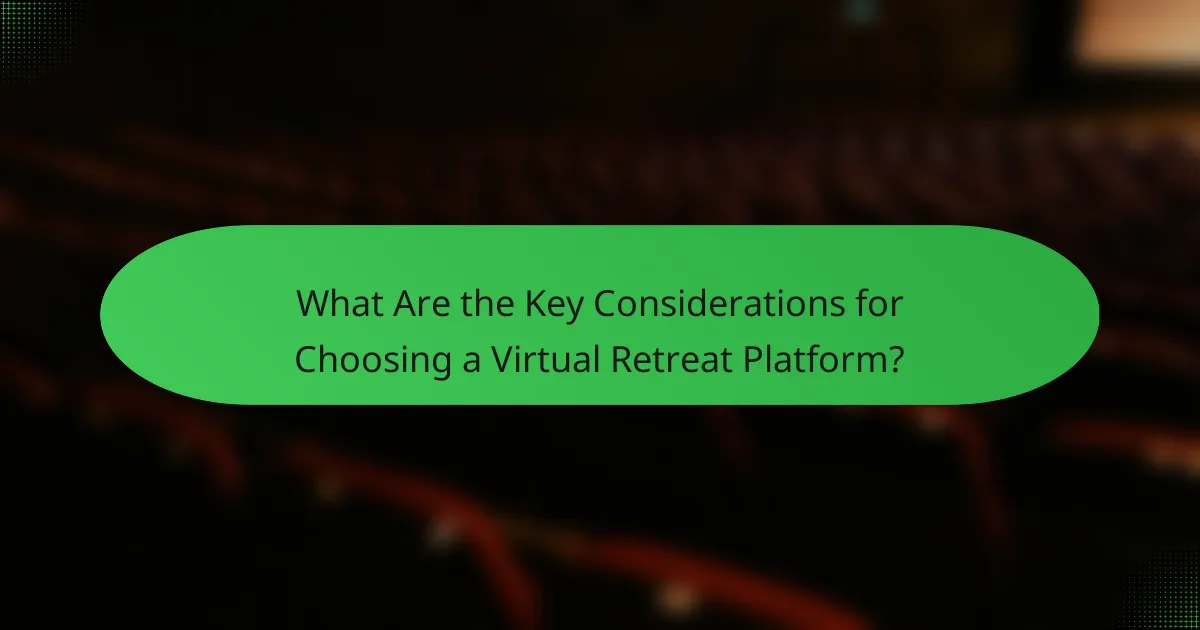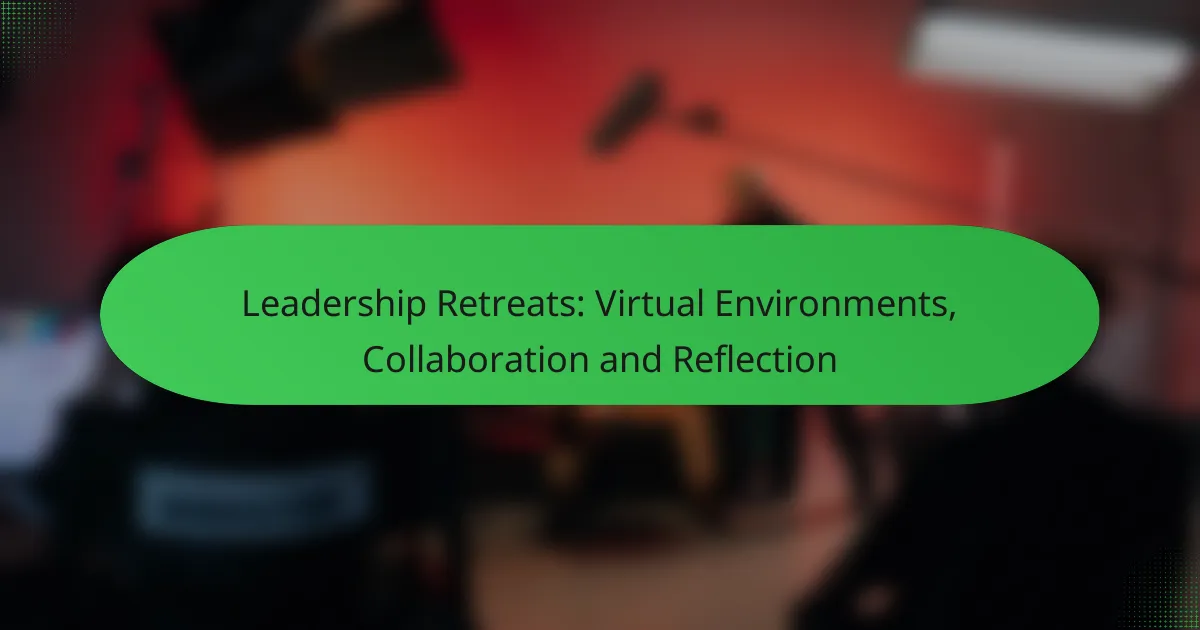Leadership retreats in virtual environments provide innovative opportunities for enhanced collaboration and reflection among team members. By utilizing advanced technology, these retreats foster engaging experiences that facilitate effective communication and teamwork, regardless of participants’ locations. Essential tools like video conferencing and collaboration software ensure that all voices are heard, leading to improved organizational outcomes.

What Are the Benefits of Leadership Retreats in Virtual Environments?
Leadership retreats in virtual environments offer unique advantages that enhance team collaboration, reflection, and overall effectiveness. These retreats leverage technology to create engaging experiences that can lead to improved outcomes for organizations.
Enhanced collaboration
Virtual leadership retreats facilitate enhanced collaboration by breaking down geographical barriers. Team members can connect from various locations, allowing for a diverse range of perspectives and ideas to emerge.
Utilizing collaborative tools like video conferencing, shared digital whiteboards, and project management software can significantly improve interaction. This technology enables real-time brainstorming and problem-solving, fostering a sense of unity among participants.
Increased reflection opportunities
Virtual retreats provide increased opportunities for reflection, allowing leaders to step back from daily operations. This time for introspection can lead to deeper insights about personal and team goals.
Structured activities, such as guided discussions or individual journaling, can be incorporated to promote thoughtful analysis. These reflective practices help leaders identify strengths and areas for improvement within their teams.
Cost-effectiveness
Conducting leadership retreats in virtual settings is often more cost-effective than traditional in-person events. Organizations can save on travel expenses, accommodation, and venue rentals, making it an attractive option for budget-conscious teams.
Investing in technology and software for virtual retreats typically incurs lower costs compared to physical logistics. This allows organizations to allocate resources to other critical areas, such as training and development.
Flexibility and accessibility
Virtual environments offer flexibility and accessibility that traditional retreats may lack. Participants can join from anywhere, making it easier to accommodate varying schedules and time zones.
This accessibility ensures that more team members can participate, leading to a richer exchange of ideas. Additionally, recorded sessions can be revisited, allowing for continued learning and engagement beyond the retreat.
Improved team dynamics
Leadership retreats in virtual environments can lead to improved team dynamics by fostering open communication and trust. Engaging activities designed for virtual settings can help break down barriers and encourage collaboration.
By focusing on team-building exercises and interactive discussions, leaders can cultivate stronger relationships among team members. This improved rapport can enhance overall productivity and morale within the organization.

How Do Virtual Leadership Retreats Foster Collaboration?
Virtual leadership retreats enhance collaboration by leveraging technology to connect participants, facilitate communication, and create an engaging environment for teamwork. These retreats utilize various tools and methods to ensure that all members can contribute effectively, regardless of their physical location.
Utilization of collaboration tools
Collaboration tools are essential in virtual leadership retreats, enabling participants to share ideas and resources seamlessly. Platforms like Zoom, Microsoft Teams, and Slack provide chat functions, video conferencing, and file sharing, making it easier for teams to work together in real-time.
Choosing the right tools is crucial. Look for platforms that offer features such as breakout rooms for small group discussions, screen sharing for presentations, and integration with project management software. This ensures that everyone can engage fully and contribute to the discussions.
Real-time feedback mechanisms
Real-time feedback mechanisms enhance collaboration by allowing participants to respond instantly to ideas and suggestions. Tools like polls, surveys, and reaction emojis can be integrated into virtual meetings to gauge opinions and foster open dialogue.
Implementing these mechanisms encourages a culture of continuous improvement. For example, using a quick poll after a presentation can help identify areas for further discussion or clarification, ensuring that all voices are heard and valued.
Structured group activities
Structured group activities are vital for fostering collaboration in virtual retreats. Activities such as brainstorming sessions, role-playing, or case studies can be designed to encourage teamwork and creative problem-solving.
To maximize effectiveness, plan activities that align with the retreat’s objectives. For instance, using breakout rooms for focused discussions can help participants dive deeper into specific topics while promoting collaboration. Ensure that each activity has clear goals and a defined timeframe to keep participants engaged and productive.

What Technologies Are Essential for Virtual Leadership Retreats?
Essential technologies for virtual leadership retreats include video conferencing platforms, collaboration software, and interactive whiteboards. These tools facilitate effective communication, teamwork, and brainstorming, enabling participants to engage meaningfully despite physical distances.
Video conferencing platforms
Video conferencing platforms are crucial for hosting virtual leadership retreats, allowing participants to connect face-to-face in real-time. Popular options include Zoom, Microsoft Teams, and Google Meet, each offering features like breakout rooms and screen sharing to enhance interaction.
When selecting a platform, consider factors such as participant capacity, ease of use, and integration with other tools. Ensure the chosen platform supports high-quality video and audio to minimize disruptions during discussions.
Collaboration software
Collaboration software enables teams to work together on projects and share resources seamlessly. Tools like Slack, Trello, and Asana help organize tasks, set deadlines, and facilitate communication among team members during the retreat.
Choose software that aligns with your team’s workflow and preferences. Look for features such as file sharing, task assignment, and real-time updates to keep everyone on the same page and enhance productivity.
Interactive whiteboards
Interactive whiteboards provide a digital space for brainstorming and visual collaboration during virtual retreats. Platforms like Miro and MURAL allow participants to create diagrams, share ideas, and engage in creative problem-solving collectively.
Utilize these tools to foster engagement and encourage participation. Set clear guidelines for how to use the whiteboard effectively, and consider assigning a facilitator to guide discussions and keep the session focused.

How to Plan an Effective Virtual Leadership Retreat?
Planning an effective virtual leadership retreat involves setting clear goals, choosing the right technology, and designing an engaging agenda. These elements ensure that participants collaborate effectively and reflect on their leadership practices in a meaningful way.
Define clear objectives
Establishing clear objectives is crucial for a successful virtual leadership retreat. Objectives should align with the overall goals of the organization and address specific leadership challenges or opportunities.
Consider using the SMART criteria—Specific, Measurable, Achievable, Relevant, Time-bound—to frame your objectives. For example, an objective might be to enhance team communication skills by 30% within three months post-retreat.
Select appropriate technology
Choosing the right technology is essential for facilitating collaboration during a virtual leadership retreat. Platforms like Zoom, Microsoft Teams, or Webex can support video conferencing, while tools like Miro or MURAL can enhance interactive brainstorming sessions.
Evaluate the needs of your participants, such as their familiarity with technology and the required features like breakout rooms or screen sharing. Ensure that all participants have access to the chosen tools and provide a brief training session if necessary.
Create an engaging agenda
An engaging agenda keeps participants focused and encourages active participation. Start with icebreakers to build rapport, followed by sessions that balance presentations and interactive discussions.
Include time for reflection and feedback, allowing participants to share insights and apply what they’ve learned. A well-structured agenda might feature short presentations, breakout discussions, and collaborative activities, ensuring a dynamic experience throughout the retreat.

What Are the Key Considerations for Choosing a Virtual Retreat Platform?
When selecting a virtual retreat platform, prioritize user-friendliness, features that enhance collaboration, and tools for reflection. These factors will significantly impact the overall experience and effectiveness of the retreat.
User-friendliness
User-friendliness is crucial for ensuring that all participants can navigate the virtual retreat platform with ease. Look for platforms that offer intuitive interfaces, clear instructions, and minimal technical jargon. This will help reduce frustration and allow participants to focus on the retreat’s objectives.
Consider platforms that provide a simple onboarding process, such as guided tours or tutorials. Features like drag-and-drop functionality and customizable layouts can also enhance user experience. Aim for platforms that require little to no technical expertise, allowing everyone to engage fully without unnecessary distractions.
Before finalizing your choice, test the platform with a small group to gauge its usability. Gather feedback on aspects like navigation, accessibility, and overall satisfaction to ensure it meets the needs of your team.


